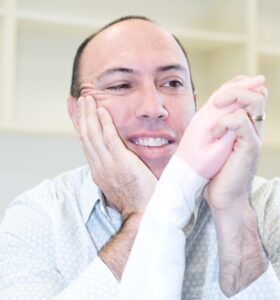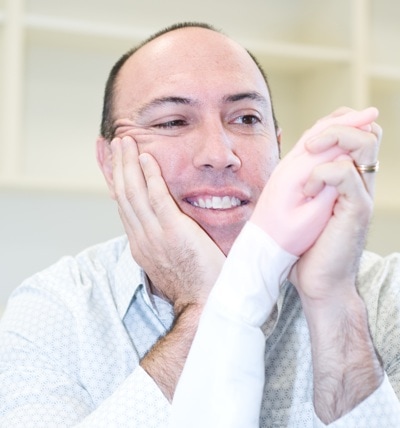There has been a lot of talk and fuss about the rubber hand illusion, since Botvinick and Cohen first described it.[1] In short, by stroking the real hand, which is out of view, and a fake rubber hand, which is in view, at exactly the same time and in synch, one can induce the illusion that it is the touch on the rubber hand that one really feels. This leads to the illusion of ownership over the rubber hand. Most of the experiments use tactile and visual input. Some use motor and visual input. Collectively, the findings tell us that tactile input and visual input seem to be important in the sense of ownership that we have over our own body. What about proprioception? Does proprioceptive input, from muscle spindles and joint receptors for example, contribute to our sense of body ownership?
Our team, of Lee Walsh (the pilot), Janet Taylor, Simon Gandevia and I (the crew), endeavoured to answer this question by setting up a plastic finger illusion. We used the finger because it is relatively straight forward to remove cutaneous input from a finger, by injecting local anaesthetic into the digital nerve. We then had healthy volunteers rate their sense of ownership over the finger, and point to where they felt their finger to be, as a way of measuring the illusion. There were three important findings. First, illusory ownership over a finger is relatively easy to induce in the same manner as that demonstrated for the arm. Second, when the skin was blocked, it was still possible to induce an illusion of ownership based on synchronous visual and proprioceptive input. That is, feedback from muscle receptors seems to contribute to our sense of bodily ownership. Third, the vividness of the illusion and its impact on perceived location of the finger, seems to be more dependent on the congruence between two modalities than it is on the number of modalities that are being integrated.
Who cares? We do, because it clearly shows that proprioception contributes to bodily ownership, not just perceived position. This fits with our recent proposal of a cortical body matrix (see the last bim post) and raises the possibility that disrupted proprioceptive input, perhaps because of injury, might impair the sense of ownership we have over the injured body part. Further experiments will explore this issue further. A final word? This is a tight and robust study for which Lee Walsh, the lead author, should be congratulated. It is published in the Journal of Physiology (London).
About Lorimer Moseley
 Lorimer is NHMRC Senior Research Fellow with twenty years clinical experience working with people in pain. After spending some time as a Nuffield Medical Research Fellow at Oxford University he returned to Australia in 2009 to take up an NHMRC Senior Research Fellowship at Neuroscience Research Australia (NeuRA). In 2011, he was appointed Professor of Clinical Neurosciences & the Inaugural Chair in Physiotherapy at the University of South Australia, Adelaide. He runs the Body in Mind research groups. He is the only Clinical Scientist to have knocked over a water tank tower in Outback Australia.
Lorimer is NHMRC Senior Research Fellow with twenty years clinical experience working with people in pain. After spending some time as a Nuffield Medical Research Fellow at Oxford University he returned to Australia in 2009 to take up an NHMRC Senior Research Fellowship at Neuroscience Research Australia (NeuRA). In 2011, he was appointed Professor of Clinical Neurosciences & the Inaugural Chair in Physiotherapy at the University of South Australia, Adelaide. He runs the Body in Mind research groups. He is the only Clinical Scientist to have knocked over a water tank tower in Outback Australia.
References
[1] Botvinick M, & Cohen J (1998). Rubber hands ‘feel’ touch that eyes see. Nature, 391 (6669) PMID: 9486643
[2] Walsh LD, Moseley GL, Taylor JL, & Gandevia SC (2011). Proprioceptive signals contribute to the sense of body ownership. The Journal of physiology PMID: 21521765




